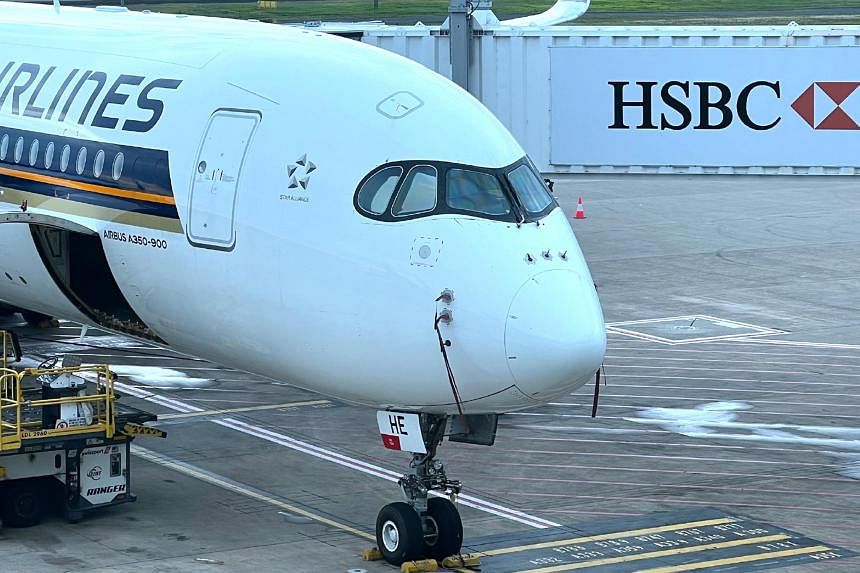SINGAPORE – The Australian authorities have found several safety issues in an incident from May 2022 involving a Singapore Airlines (SIA) jet, in which the covers of its pitot probes were not removed as it was about to depart from Brisbane Airport.
The probes or tubes, which measure air pressure to assess airspeed, are especially important for take-off and the initial climb.
They are routinely covered during turnarounds at Brisbane Airport, in the capital of Australia’s Queensland, as mud wasps can build nests in them within just 20 minutes.
The covers must be removed about 20 minutes before departure for SIA flights. Blockage of these probes could result in inaccurate or absent airspeed readings, which can lead to unsafe flight conditions.
Just before the Airbus A350 aircraft pushed away from the gate for departure on May 27, 2022, a refueller in the next bay alerted a licensed aircraft maintenance engineer with Heston MRO, SIA’s engineering maintenance contractor in Brisbane, to the fitted pitot covers.
The engineer removed the covers at 9.18am, two minutes to the scheduled departure time of 9.20am, and the aircraft later took off for Singapore.
The findings from the final report on the incident, published by the Australian Transport Safety Bureau (ATSB) on March 15, showed that Heston MRO failed to adhere to procedures.
It also found that SIA’s flight crew had not effectively carried out pre-flight inspections, in which a pilot walks around the aircraft to ensure visible equipment is safe for flight.
The bureau, based on its review of closed-circuit television (CCTV) camera footage of five SIA turnarounds at Brisbane Airport from May 23 to 27 in 2022, flagged that none of the inspections by SIA pilots was fully completed.
SIA’s procedures dictate that flight crew must carry out these inspections about 30 minutes before departure.
While the flight crew operating the flight in question should still expect to see the probe covers fitted then, the ATSB noted it is critical for inspections to be “completed in full and with careful diligence”.
In January 2024, SIA told the bureau it had published a memo, and later a notice, to its pilots on Dec 12, 2023, emphasising the importance of adhering to procedures regarding these inspections.
The airline added that it had engaged Heston MRO to use more visible and longer probe covers.
Responding to ST’s queries on March 19, SIA said it has worked with its engineering teams and pilots to strengthen its procedures. The airline did not specify how it is enforcing pilots’ adherence to pre-flight inspection protocol when asked.
“The safety of our customers and staff is always our No. 1 priority,” it added.
Besides pre-flight inspections, final walk-arounds – which are done by maintenance crew – are also required.
From the review of CCTV footage of the five SIA turnarounds, final engineering walk-arounds done by Heston MRO were completed fully from May 23 to 26, but had not been carried out for the May 27 flight in 2022.
During these final walk-arounds after all aircraft doors are closed, an engineer must ensure, among other things, that all covers and pins are removed.
On the day of the incident, the licensed aircraft maintenance engineer noted in a technical log that the probe covers had been removed, and removed a placard stating the covers were fitted from the plane’s cockpit, without visually or verbally confirming that the covers had been removed.
He assumed an aircraft maintenance engineer he was supervising had removed them, but the more junior engineer – who had started work just three weeks before – had been told not to remove the covers without instruction.
The ATSB also found that Heston MRO did not roll out a previous proposal accepted by the ATSB to account for equipment before an aircraft is towed away from the gate.
In February 2022, Heston MRO had proposed to audit the contents of all toolboxes – which include probe covers – being taken to an aircraft, and reaudit them to ensure all contents were returned before the aircraft leaves the gate.
This was after an incident involving a Malaysia Airlines Airbus A330 jet that departed from Brisbane with its pitot covers still fitted in July 2018. The crew had to turn the plane back to Brisbane Airport.
In the SIA incident, the bureau highlighted several factors that increased safety risks, including the dual roles of the licensed aircraft maintenance engineer, who was also Heston MRO’s regional manager for south-east Queensland. Heston MRO also did not track the working hours of crew with dual roles.
This increased the risk of fatigue-related incidents involving staff.
When asked about his level of fatigue on the day of the incident, the licensed aircraft maintenance engineer said he was “moderately tired and let down” on most days, which is five on an alertness scale from one to seven – with one being fully alert and seven being completely exhausted.
He added that he could not remember the last time he had a full day of rest, noting that he was “working to catch up with duties” even at home.
In January 2024, Heston MRO told the ATSB it was completing a review of its tool control procedures. The changes will include a more specific requirement to review and document a check of the toolbox before an aircraft is released to service.
The company also employed an independent regional manager who will not hold a maintenance role. It will also require its staff, including engineers, to submit time sheets to better manage fatigue. ST has contacted Heston MRO for comment.

